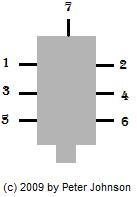Recently the Bluetooth battery status on my DCF888 impact driver was being reported as poor in the Dewalt Tool Connect app and then I noticed it wasn’t connecting anymore. I decided to ignore the warning that it wasn’t user replaceable and have a go at replacing the coin cell myself.
Disassembly was easy enough, there are eight T10 Torx screws and they’re all the same length so no need to keep track of where they came from. One of the lower screws is set fairly low into the enclosure so you’ll need a dedicated T10 driver rather than a 1/4″ Torx bit. The only other trick is to peel back the “Brushless Motor” sticker at the back and “Tool Connect” sticker at the bottom back 50% so the two halves of the case will separate.
But upon peeking around no coin cell to be seen! The Bluetooth module is a rectangular module above where the Li-Ion battery fits with the nameplate on the bottom but the top was filled with white potting compound and I feared the coin cell was within the hard potting mix. After some searching I found that this was the case and the following gives the part number:
The part required is number 26 and simply labeled as “Module” with part number N559222. The only place I could find the part for sale was on E-Bay at $US58 + $US38 shipping and charges to Australia = $US96 or $AUD150 at the moment! The module has a 4-pin connector and would have been easy enough to replace but I decided to pass at that price.
While searching I found a few references to people having problems with the DCF888 not operating at all with a dead Bluetooth cell. However in my case it continues to work well and with a Li-Ion battery installed I can connect and configure the tool so I think I can live without Bluetooth when the main battery isn’t installed.

